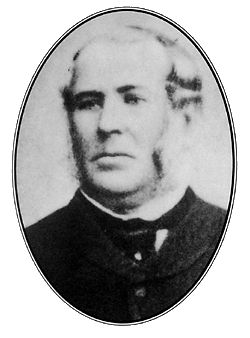
Council of Heads of Australasian Herbaria
Australian National Herbarium
Biographical Notes
 |
Council of Heads of Australasian Herbaria |
 Curdie, Daniel (1810–1884)
Curdie, Daniel (1810–1884) Born at Slidderie, Arran, Scotland, 9th January, 1810, died on 22nd February 1884.
He was the sixth son of Daniel Mac Curdy. Received his preliminary education at the town of Ayr, and took his M.A. degree at Glasgow in 1832; then proceeding to Edinburgh, he graduated M.D. there in 1838. Amongst his class-mates were David Livingstone and Archibald Campbell Tait.
He left in the ship Caledonia, arriving in Sydney on the 29th September, 1839. Mitchell had recently discovered "Australia Felix" and after inspecting portions of New South Wales and deciding that squatting would pay better than the medical profession, Dr. Curdie and his nephew overlanded to Port Phillip, and, on reaching Melbourne, camped with their stock on the site of the present Botanic Gardens. On 8th October, 1840, Dr. Curdie fixed his homestead at "Tandarook," 12 miles south of the present town of Camperdown. "Tandarook," is believed to signify in an Aboriginal language a place where the "native bread " fungus (Polyporus mylittoe) is to be found. For 11 years Dr. Curdie combined squatting with the practice of his profession.
In 1845 he followed Curdie's River down to the sea, and the estuary was called Curdie's Inlet after him. He left for Europe on "Black Thursday" (7th February, 1851), and in Scotland, continuing his studies of sea-weeds, he was so fortunate as to discover a new one. He returned to Melbourne, with a wife, on 14th January, 1854.
He was an enterprising pastoralist, who unselfishly devoted time and means to many objects for the public good.
Dr Curdie frequently exchanged letters with Robert Brown, and also with Sir Joseph Hooker, on matters of Victorian botany. He was a correspondent for many years of Mueller's, who often visited "Tandarook".
He took a great interest in the Melbourne University, and was for many years a member of the Senate. He was admitted ad eundem gradum on 23rd April, 1870. He was a member of the Government expedition sent to observe the total eclipse of the sun at Cape York in 1872 in the steamer Governor Blackall. The trip enabled him to study sea-weeds under favourable conditions; this was the branch of botany to which he devoted special attention. Mrs. Curdie was also a highly educated woman, and her tastes lay in the direction of botany and horticulture.
Dr. Harvey, the great algologist, who visited Victoria in 1855, collected sea-weeds with Dr. Curdie at the mouth of the Glenelg River and other places. He figured in his “Phycologia Australica" the following sea-weeds by which he commemorated Dr. Curdie: Curdiea laciniata, C. obtusata and Nitophyllum curdieanum.
Source:
Maiden, J.H. (1908). Records of Victorian Botanists. Victorian Naturalist 25:101–117